Related Research Articles

Hibiscus tiliaceus is a species of flowering tree in the mallow family, Malvaceae, that is native to the Old World tropics. Common names include sea hibiscus, beach hibiscus, coastalhibiscus, coastalcottonwood, green cottonwood, native hibiscus, native rosella, cottonwood hibiscus, kurrajong, sea rosemallow, balibago (Tagalog), malabago or malbago, maribago, waru (Javanese), baru or bebaru (Malay), pagu (Chamorro), hau (Hawaiian), fau (Samoan), purau (Tahitian), and vau tree. The specific epithet, "tiliaceus", refers to its resemblance of the leaves to those of the related Tilia species.
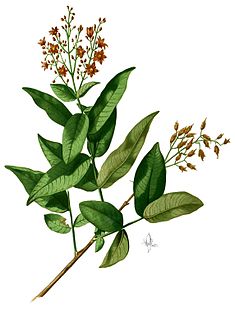
Cratoxylum is a genus of flowering plants in the family Hypericaceae, native to tropical Asia. The generic name is from the Greek meaning "strong wood", referring to the timber.
Holttumochloa is a genus of Malaysian bamboos in the grass family native to the hill forests of Peninsular Malaysia. It is sometimes included in the genus Bambusa.
Kinabaluchloa is a genus of Southeast Asian bamboos in the grass family.
Temburongia is a genus of bamboo from the Sultanate of Brunei on the Island of Borneo. It is usually classified in the subtribe Shibataeinae, though its exact relationship with the subtribe remains unclear.
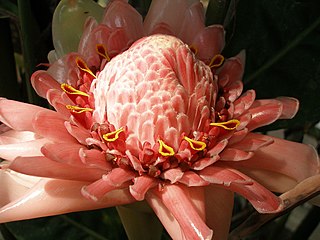
Etlingera elatior is a species of herbaceous perennial plant. Botanical synonyms include Nicolaia elatior, Phaeomeria magnifica, Nicolaia speciosa, Phaeomeria speciosa, Alpinia elatior, and Alpinia magnifica.
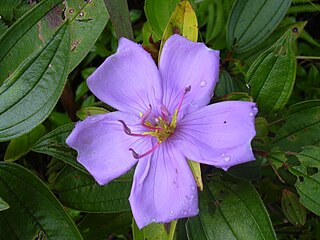
Melastoma is a genus in the family Melastomataceae. It has over 100 species distributed around Southeast Asia, India, north to Japan, south to Australia and the Pacific Islands. The number of species should probably be reduced according to some sources. Many species have been planted around the world for the aesthetic value of their bright purple flowers.

Cratoxylum maingayi is a plant in the family Hypericaceae. It is named for the botanist Alexander Carroll Maingay.
Mesua kochummenia is a species of flowering plant in the family Calophyllaceae. It is endemic to Peninsular Malaysia. It is threatened by habitat loss.
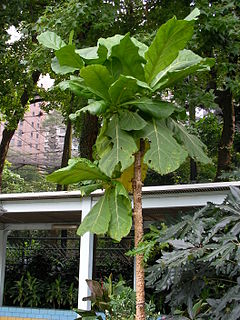
Fagraea is a genus of plants in the family Gentianaceae. It includes trees, shrubs, lianas, and epiphytes. They can be found in forests, swamps, and other habitat in Asia, Australia, and the Pacific Islands, with the center of diversity in Malesia.

Rothmannia is a genus of flowering plants in the family Rubiaceae. It was described in 1776 and is named for Göran Rothman (1739–1778) by Thunberg – both were pupils of Linnaeus.
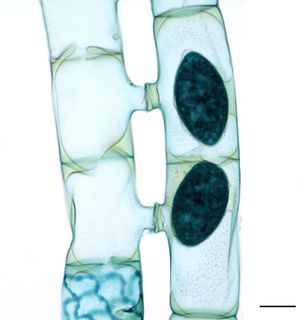
Zygnematophyceae is a class of green algae in the division Charophyta, consisting of more than 4000 described species. It contains the order Zygnematales. The Desmidiales emerged within the Zygnematales. The Zygnematophyceae are the sister clade of the Mesotaenium, together forming the sister clade of the land plants. The body plan of Zygnematophyceae is simple, and appear to have gone through a secondary loss of morphological complexity. They contain genes involved in protection from desiccation that appear to have been derived by horizontal gene transfer from bacteria; the genes are found in plants, Zygnematophyceae, bacteria, but no other organisms. The genes may have helped to enable plants to make the transition to life on land.

Homalomena is a genus of flowering plants within the family Araceae. Homalomena are primarily found in southern Asia and the southwestern Pacific, but there are a few species that are known to be indigenous to Latin America. Many Homalomena have a strong smell of anise. The name derives apparently from a mistranslated Malayan vernacular name, translated as homalos, meaning flat, and mene = moon.

Aroideae is a subfamily of flowering plants in the family Araceae. It is the largest subfamily in Araceae and consists of about 72 different genera, and 2,300 species. Many Aroideae have spiny pollen grains without a sporopollenin outer exine layer and lacking an aperture.
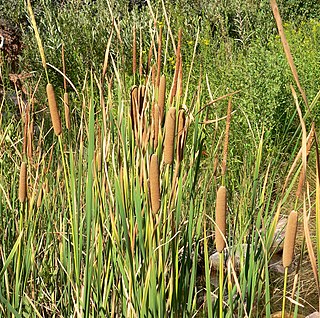
Typha domingensis, known commonly as southern cattail or cumbungi, is a perennial herbaceous plant of the genus Typha.
Bungarimba is a genus of flowering plants in the family Rubiaceae. The type species was transferred from Porterandia by K.M. Wong in 2004. The genus is found from Borneo, Malaysia, Sumatra and New Guinea.

Gardenieae is a tribe of flowering plants in the family Rubiaceae and contains about 586 species in 53 genera.

Kenneth S. Norris Rancho Marino Reserve is part of the University of California Natural Reserve System. The reserve is located along the coast of San Luis Obispo County at the south end of the town of Cambria, California. It is named for Kenneth S. Norris, a University of California professor, renowned naturalist, and founder of the UC Natural Reserve System. It is operated by the University under a use agreement, as it is privately owned and funded. There is no public access.
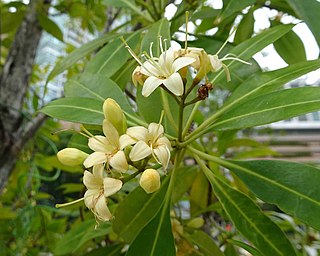
Cyrtophyllum is a genus of tropical Asian tree species in the family Gentianaceae and the tribe Potalieae. Species may have previously been placed in the genus Fagraea and can be found in Indo-China and Malesia.
Utania is a genus of flowering plants belonging to the gentian family (Gentianaceae), the tribe Potalieae, and the subtribe Potaliinae. A small genus it has 12 species.
References
| | This Ixoroideae article is a stub. You can help Wikipedia by expanding it. |